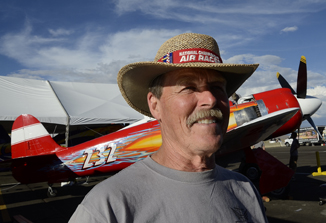Back in the Race at Reno
Not all the new safety measures are welcome, but the teams are upbeat, and happy to be racing again
/https://tf-cmsv2-smithsonianmag-media.s3.amazonaws.com/filer/ac/c6/acc62d2e-1a19-443b-95c9-b35478f988bc/sea-furys-reno.jpg)
The 2012 National Championship Air Races are underway — an event that many believed had run its last race last year after pilot Jimmy Leeward crashed into the crowd, killing himself and 10 spectators. Last year’s tragedy changed things here in Reno, in ways that are barely perceptible to race fans. The most noticeable change was psychological; those of us who watched the P-51 Strega handily win the Unlimited Gold heat Friday afternoon breathed a little easier at the race’s end, reassured that a race could be flown without calamity. (It was during a race of the Unlimited class last year when Leeward’s airplane got away from him.)
At the recommendation of the National Transportation Safety Board, the air racing association has modifed the course, bringing its boundary 150 feet farther in from the grandstands and softening the turn around the pylons closest to the race’s finish. The airplanes don’t seem farther away than they were last year, but they are. The fuel trucks that had been lined up along the ramp are gone, moved to a location farther from the race course.
The new course is “workable,” said race pilot and former astronaut Hoot Gibson, who flew Sea Fury 232 to second place in the heat that Strega won. On the smaller course, the race pilots pull more Gs than in the past. “It’s not causing me any difficulty,” Gibson said, “but I was a fighter pilot and I’ve had 41 years of experience pulling Gs.”
What’s not workable, according to Gibson, is the 250-foot altitude limit, also a recommendation of the NTSB. The altitude limit is the result of a calculation: how far a piece flying off an airplane would travel. The so-called “scatter radius” is smaller at a lower altitude and the imposition of the limit would theoretically keep a piece of an airplane from flying into the crowd of spectators. In the 48 years of racing at Reno, an airplane part has never flown into the crowd, so the altitude limit seems a solution in search of a problem. And it’s a dangerous solution. “If you get three airplanes rounding a pylon together, the only place you can go is up,” Gibson said. “This is a safety issue and they’re going to have to fix this next year. You’re asking for a mid-air.”
The racing association is also looking harder at modifications that owners make to the raceplanes. Leeward’s aircraft was barely recognizable as a P-51; the air scoop had been eliminated and cooling system changed from air to water cooling, and the wings had been shortened. But technical inspectors here, the crew chiefs who have to submit the paperwork, the board members in charge of reviewing the documentation—all had difficulty describing what exactly had changed in this regard: Racing association technical inspectors have always checked the aircraft before they’re raced; the results of that inspection have always been documented and reviewed by association teams and Federal Aviation Administration officials.
In the pits, the teams are upbeat, happy to be racing again. Pete Blood of Billings, Montana, who maintains the Tigercat Here, Kitty Kitty, called this year’s gathering “the best healing event.”
The world rarely notes what goes on at the Reno air races, unless a tragedy like last year’s shoves the event into the headlines. Most of the people reading those headlines have never seen an air race and can’t fathom why, despite the danger, the race community is so passionate about keeping the sport alive. This year especially, when the race teams and fans converge on Reno for this unique event, they’re back among friends who understand.
